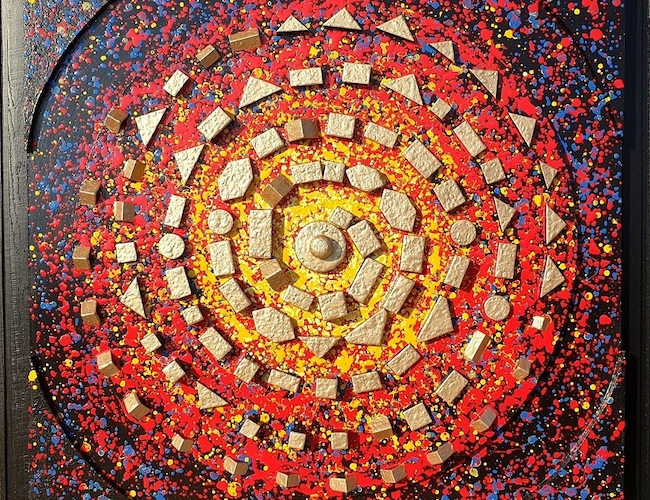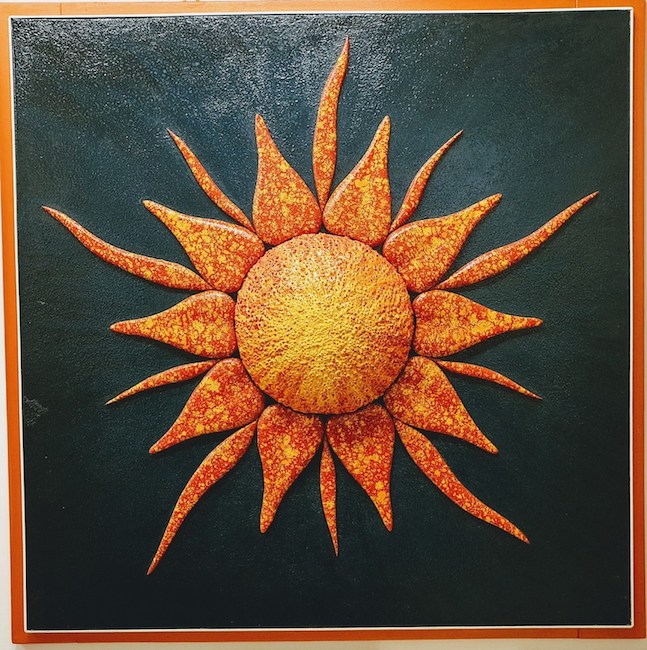L’approccio moderno all’arte presuppone un atteggiamento sperimentale, poco incline a restare ingabbiato all’interno di linee guida ben definite che toglierebbero al creativo la libertà espressiva e di azione necessarie per dare interpretazione e voce alla propria indole artistica; nell’ambito di questo tipo di atteggiamento privo di regole, di schemi ben delineati e di condizionamenti stilistici, persino la scelta dei supporti e delle tecniche diviene non solo funzionale al messaggio e alla sperimentazione del singolo artista, ma anche una modalità per dare sfogo a quell’innata curiosità a quella poliedricità che impedisce ad alcuni di fermarsi a un solo linguaggio espressivo. L’artista di cui vi parlerò oggi è giunto allo stile attuale a seguito di un lungo percorso di evoluzione e di trasformazione in cui ha avuto modo di muoversi trasversalmente verso stili e tecniche diverse tra loro.
L’eclettismo artistico, la necessità di misurarsi con tecniche diverse e a volte persino quasi diametralmente opposte tra loro, è appartenuto a quasi tutti i principali protagonisti del Ventesimo secolo proprio perché il sentirsi limitati all’interno di un solo canale espressivo era limitante in un periodo in cui, se era vero che le correnti pittoriche erano ben distinte le une dalle altre, lo era altrettanto che non era più possibile confinare un artista a un solo movimento per tutta la sua carriera, né tanto meno poteva essere frenato il suo impulso a misurarsi anche in ambiti artistici diversi da quelli in cui si muoveva abitualmente. Già a fine Ottocento Henri de Tolouse-Lautrec, si divise tra la pittura e la realizzazione di manifesti pubblicitari, quelli realizzati per il Moulin Rouge, locale da lui abitualmente frequentato, così come l’Art and Crafts inglese promosse la necessità di un connubio tra le arti applicate che comprendesse anche l’artigianato, il decoro, la realizzazione di tappeti, tessuti, carte da parati che contraddistinsero tra gli altri la produzione di William Morris. Dunque l’arte estendeva il suo campo espressivo così come i suoi esponenti tendevano ad avvertire la necessità di misurarsi su diversi fronti, più per soddisfare una propria tendenza interiore che non per adeguarsi alle innovazioni dei tempi; Giacomo Balla, grande rappresentante del Futurismo, fu talentuoso pittore ma anche eccellente scultore, Pablo Picasso si cimentò non solo nelle celeberrime opere pittoriche appartenenti al movimento da lui fondato, il Cubismo, bensì era anche scultore e litografo, tanto quanto il surrealista Joan Mirò fu, oltre che pittore e scultore, anche ceramista. E fu proprio il Surrealismo ad aprire ancora di più le porte alla sperimentazione poiché da Salvador Dalì a Man Ray, gli appartenenti alla corrente artistica erano spesso pittori, scultori, cineasti, fotografi, grafici e realizzarono oggetti surrealisti proprio per sottolineare quanto lo stile espressivo potesse divenire una filosofia di vita. Nell’ambito di questa poliedricità alcuni artisti sperimentarono anche una trasformazione di stile, passando da una modalità espressiva più figurativa a una più astratta, muovendosi trasversalmente tra forme differenti che sono l’una l’evoluzione dell’altra proprio perché l’esigenza maggiore è quella di porsi davanti a continue sfide artistiche, senza fermarsi alla completa conoscenza di un settore specifico bensì inseguendo costantemente il non conosciuto, il qualcosa ancora da scoprire.
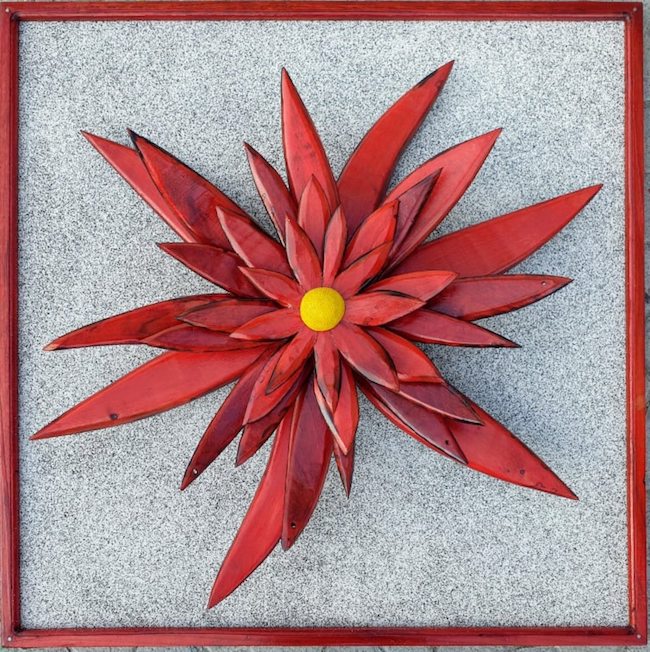
Corrado Cagli fu uno di questi poliedrici sperimentatori, modificando costantemente il suo stile sulla base dell’ispirazione del momento pittorico; a suo modo Sergio Gatta, classe 1950 dunque tra gli artisti che il Novecento lo hanno vissuto in pieno riuscendo a esserne protagonisti, ha realizzato il suo percorso nel mondo dell’arte scegliendo sempre la libertà espressiva, quella che lo ha condotto a passare dall’incisione su acquaforte e ai dipinti con betulle, in cui emergeva la vicinanza al Simbolismo e al Surrealismo, all’Astrattismo pittorico vicino allo stile di Vassily Kandinsky e, in alcune opere a quello di Jackson Pollock, fino a giungere alla forma espressiva attuale, quella della scultura del legno attraverso cui dà vita anche a pittosculture in cui esalta, grazie all’abilità nell’uso delle sgorbie, le venature e la bellezza cromatica che emerge a seguito dell’accurata levigatura.
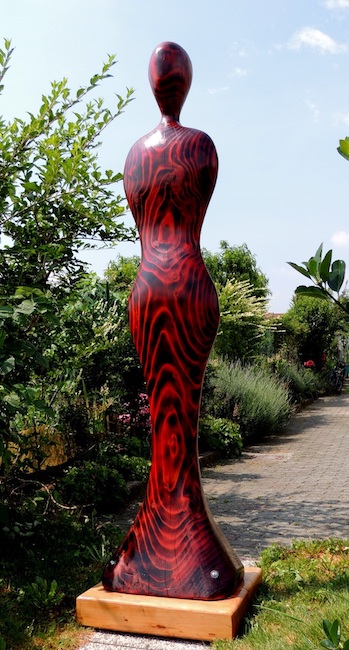
È affascinato dagli elementi naturali ma anche da quelli che furono simboli fondamentali delle antiche civiltà, come il sole, il fuoco, le piramidi, che poi rielabora attualizzandoli come a suggerire all’osservatore quanto in realtà, malgrado il progresso, a dispetto delle evoluzioni che si sono susseguite nel corso dei secoli, l’uomo sia ancora fortemente legato proprio a quegli elementi perché sono in fondo la base della vita.
In particolare il sole viene rappresentato sotto diverse forme e sfaccettature nelle sue pittosculture in cui la tecnica mista è essenziale tanto quanto il soggetto stesso perché ciò che appassiona di più Sergio Gatta è quella sperimentazione a cui non riesce a rinunciare poiché costituisce il fondamento del suo percorso artistico; nell’opera Sole girasole l’astro che consente la vita, che scalda in virtù del suo calore, viene rappresentato in modo fortemente stilizzato, in legno su cui l’artista inserisce semi di spinaci colorati in una seconda fase con smalti. L’opera è di forte impatto, sembra voler raggiungere lo spazio circostante per propagare la sua forza e la sua energia all’ambiente intorno a sé.
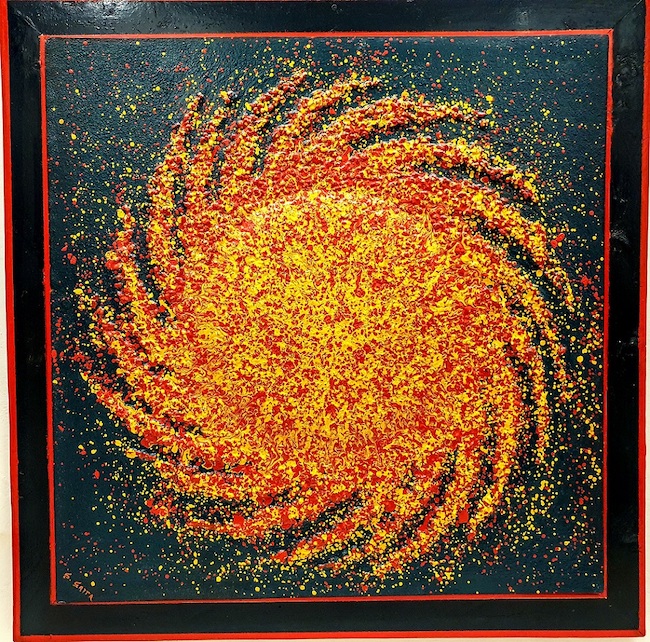
In Sole rotante invece Sergio Gatta si avvicina all’Astrattismo, e più precisamente all’Informale Materico, attraverso cui dà una versione più concettuale della stella più luminosa della nostra galassia; anche in questo caso emerge il senso di devozione che l’artista ha nei confronti di qualcosa che sa essere imprescindibile poiché la maggior parte della vita sulla terra dipende proprio dal sole. Qui l’immagine finale è ottenuta con l’utilizzo di semi di girasole e di una finitura con smalti rimandando così un’immagine ruvida ma incredibilmente luminosa.
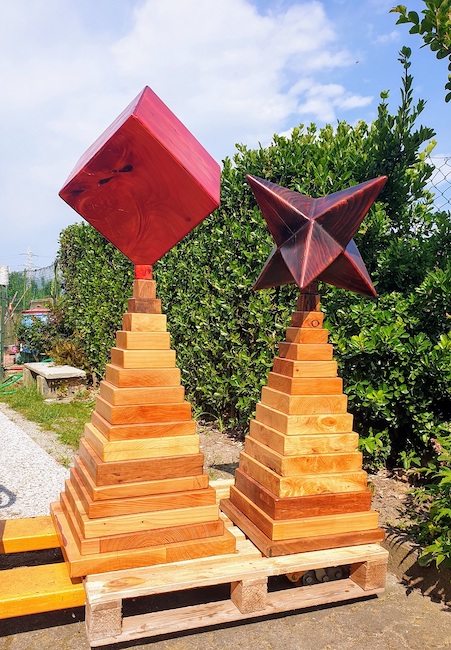
Nelle sculture Gatta torna a quella necessità di andare a esplorare il mistero che avvolge l’esistenza e che l’ha sempre avvolta da molti secoli perciò si interroga sulle similitudini tra passato e presente, in particolar modo nelle sculture Forme rotanti su piramidi in cui le piramidi sostengono la sfera e il cubo allo stesso modo in cui le radici indimenticabili del passato, malgrado i tentativi di dimenticarlo, allontanarlo, superarlo, fanno indissolubilmente parte dell’identità della razza umana e sorreggono, malgrado tutto, le difficoltà e il disequilibrio dell’uomo contemporaneo, quel voler tendere verso il progresso dimenticando che senza le solide basi delle civiltà antiche, alla loro lungimiranza, alle loro scoperte, non vi sarebbe stato nulla.
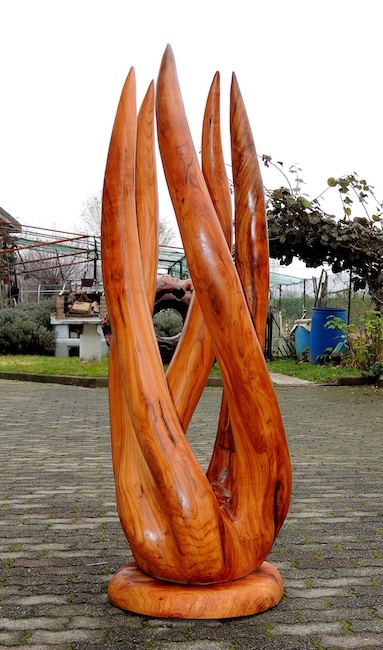
Nella scultura Fiamme zanna Sergio Gatta sottolinea l’importanza dell’elemento fuoco che ha in natura una doppia valenza, quella distruttiva poiché se mal gestito e controllato in grado di distruggere tutto ciò che incontra, oppure quella positiva di scaldare, di permettere di avere luce quando quella del giorno non c’è, costituendo dunque un punto di riferimento per le antiche tribù che oggi vengono chiamate famiglie; le lunghe fiamme vanno verso l’alto, sono positive, protettive quasi, non intendono propagarsi verso l’esterno bensì si mantengono circoscritte a sottolineare l’importanza che hanno avuto nel corso della storia e che ancora hanno. Il legno di ciliegio con cui è realizzata la scultura rivela tutta la sua bellezza, tutta la sua maestosità grazie al sapiente intervento di Sergio Gatta che è riuscito a esaltarne le venature quasi come se fossero fiammelle minori ad alimentare il corpo principale del rogo.
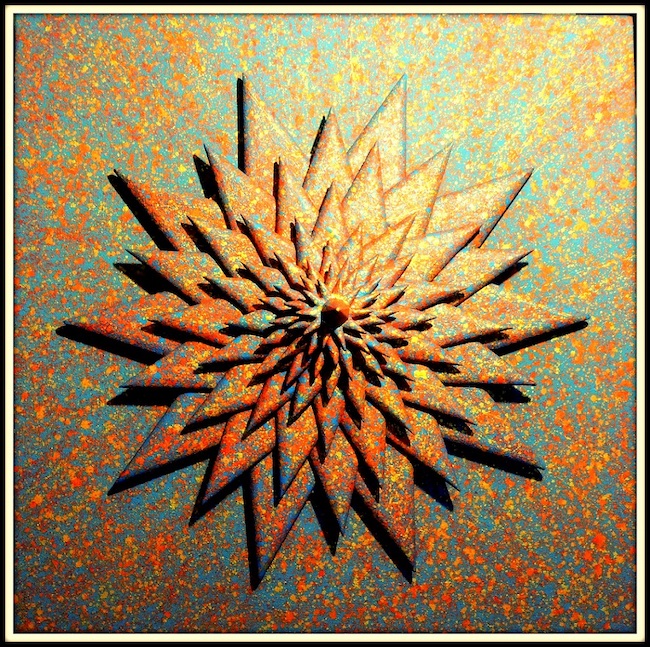
La ricerca su cui si è sempre fondato il cammino artistico di Sergio Gatta lo ha condotto a misurarsi non solo con pittura, scultura, acqueforti, ma anche con oggetti di artigianato come tavoli e sedie intagliati e ricavati da grandi tronchi di alberi che ormai hanno terminato il loro ciclo vitale; nel corso della sua lunga carriera artistica si è dedicato anche al restauro di oggetti sacri, alla produzione di stampe, alla doratura con foglia oro, insomma un approccio polivalente che lo fa tendere verso una continua evoluzione necessaria alla sua personalità artistica. Sergio Gatta ha all’attivo mostre collettive e personali durante le quali ha riscosso grandi apprezzamenti, ha partecipato a premi d’arte ricevendo molti riconoscimenti permettendo alle sue opere di essere apprezzate in Italia e all’estero.
SERGIO GATTA-CONTATTI
Email: sergiogatta59@gmail.com
Sito web: http://www.sergiogatta.it
Facebook: https://www.facebook.com/sergio.gatta.3
Instagram: https://www.instagram.com/sergiogatta59/
The versatile face of wood, between Surrealism and Abstractionism in Sergio Gatta’s sculptures
The modern approach to art presupposes an experimental attitude, unwilling to remain caged within well-defined guidelines that would deprive the creative person of the freedom of expression and action necessary to give interpretation and voice to his artistic nature; in the context of this type of attitude devoid of rules, well-defined schemes and stylistic conditioning, even the choice of media and techniques becomes not only functional to the message and experimentation of the single artist, but also a way to give vent to that innate curiosity and versatility that prevents some from stopping at a single expressive language. The artist I am going to talk about today has arrived at his current style following a long process of evolution and transformation in which he has been able to move transversally towards different styles and techniques.
Artistic eclecticism, the need to measure against different and sometimes even almost diametrically opposed techniques, belonged to almost all the main protagonists of the twentieth century precisely because feeling limited within a single expressive channel was limiting in a time when, while it was true that pictorial currents were quite distinct from one another, it was also true that it was no longer possible to confine an artist to a single movement for his entire career, nor could be restrained his impulse to measure himself in artistic fields other than those in which he usually worked. As early as the end of the 19th century, Henri de Tolouse-Lautrec divided his time between painting and producing advertising posters for the Moulin Rouge, a venue he frequented regularly, just as English Art and Crafts promoted the need for a union between the applied arts that also included craftsmanship, decoration and the production of carpets, fabrics and wallpaper that distinguished the work of William Morris, among others. So art extended its field of expression, just as its exponents tended to feel the need to measure themselves on different fronts, more to satisfy their own inner tendency than to adapt to the innovations of the times; Giacomo Balla, the great representative of Futurism, was a talented painter as well as an excellent sculptor, Pablo Picasso was not only a famous painter in the movement he founded, Cubism, but was also a sculptor and lithographer, just as the Surrealist Joan Mirò was not only a painter and sculptor but also a ceramist.
And it was Surrealism that opened the doors to experimentation even wider, since from Salvador Dali to Man Ray, the members of the artistic movement were often painters, sculptors, filmmakers, photographers and graphic designers, and they created Surrealist objects to underline how expressive style could become a philosophy of life. In the context of this multifaceted nature, some artists also experimented with a transformation of style, passing from a more figurative to a more abstract expressive mode, moving transversally between different forms that are the evolution of one another precisely because the greatest need is to set oneself continuous artistic challenges, without stopping at complete knowledge of a specific sector but constantly pursuing the unknown, something yet to be discovered. Corrado Cagli was one of these multifaceted experimenters, constantly modifying his style on the basis of the inspiration of the pictorial moment; in his own way, Sergio Gatta, born in 1950 and therefore one of the artists who lived the twentieth century to the full and succeeded in being a protagonist, made his way through the art world always choosing freedom of expression, which led him to move from etching and paintings with birch trees, in which emerged his closeness to Symbolism and Surrealism, to pictorial Abstractionism close to the style of Vassily Kandinsky and, in some artworks, to that of Jackson Pollock, until he reached his current form of expression, that of wood sculpture through which he also creates pictosculptures in which he enhances, thanks to the skillful use of gouges, the grain and the chromatic beauty that emerges after careful polishing. He is fascinated by natural elements, but also by those that were fundamental symbols of ancient civilisations, such as the sun, fire and pyramids, which he then reworks, bringing them up to date as if to suggest to the observer that in reality, despite progress, in spite of the evolutions that have taken place over the centuries, man is still strongly attached to those very elements because they are, after all, the basis of life.
In particular, the sun is represented in different forms and facets in his pictosculptures, in which the mixed technique is as essential as the subject itself, because what most fascinates Sergio Gatta is that experimentation which he cannot give up, as it constitutes the foundation of his artistic career. In the artwork Sun sunflower, the life-giving, warming star is represented in a highly stylised way, in wood on which the artist inserts spinach seeds coloured in a second phase with enamels. The work has a strong impact; it seems to want to reach out to the surrounding space to propagate its strength and energy to the surrounding. In Sole rotante (Rotating Sun), on the other hand, Sergio Gatta moves closer to Abstractionism, and more specifically to Materic Informal, through which he gives a more conceptual version of the brightest star in our galaxy; here too emerges the artist’s sense of devotion to something he knows to be indispensable, since most of life on earth depends on the sun. Here the final image is achieved by the use of sunflower seeds and an enamel finish giving a rough but incredibly luminous image. In his sculptures Gatta returns to that need to explore the mystery that envelops existence and has always enveloped it for many centuries so he questions the similarities between past and present, particularly in the sculptures Forme rotanti su piramidi (Rotating Forms on pyramids) in which the pyramids support the sphere and the cube in the same way as the unforgettable roots of the past, in spite of attempts to forget it, distance it, overcome it, are indissolubly part of the identity of the human race and support, in spite of everything, the difficulties and imbalance of contemporary man, that desire to strive towards progress forgetting that without the solid foundations of ancient civilisations, their foresight, their discoveries, there would be nothing. In the sculpture Fiamme zanna (Flames fang), Sergio Gatta underlines the importance of the element fire, which in nature has a twofold significance, either destructive, since if poorly managed and controlled it is capable of destroying everything it encounters, or positive, warming, allowing light when there is no daylight, and thus constituting a point of reference for the ancient tribes that are now called families; the long flames go upwards, they are positive, almost protective, they do not intend to spread outwards but rather remain contained to underline the importance they have had throughout history and still have.
The cherry wood used to make the sculpture reveals all its beauty, all its majesty, thanks to the skilful intervention of Sergio Gatta, who has succeeded in exalting the grain almost as if it were minor flames feeding the main body of the fire. The research on which Sergio Gatta’s artistic career has always been based has led him to measure himself not only with painting, sculpture and etchings, but also with handcrafted objects such as tables and chairs carved from large tree trunks that have now reached the end of their life cycle. During his long artistic career he has also devoted himself to the restoration of sacred objects, the production of prints, and gilding with gold leaf, in short, a multi-faceted approach that makes him strive towards a continuous evolution necessary for his artistic personality. Sergio Gatta has had both group and personal exhibitions, during which he has received great appreciation, and has taken part in art prizes, receiving many awards and enabling his artworks to be appreciated in Italy and abroad.


